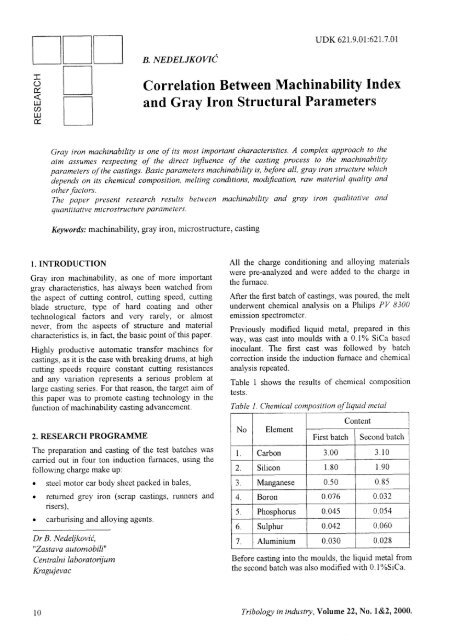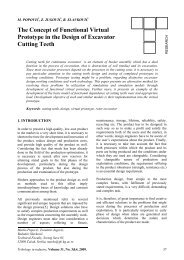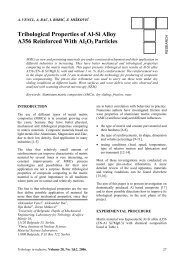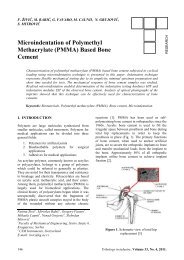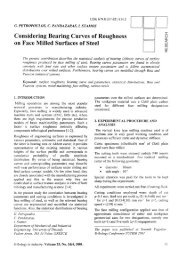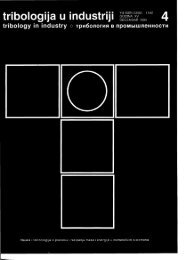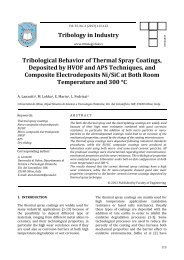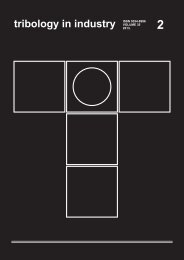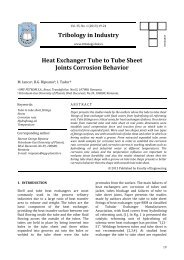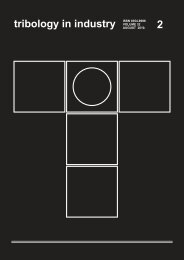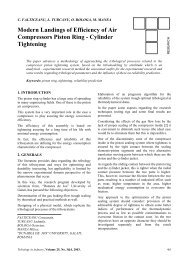Correlation Between Machinability Index and Gray Iron Structural ...
Correlation Between Machinability Index and Gray Iron Structural ...
Correlation Between Machinability Index and Gray Iron Structural ...
Create successful ePaper yourself
Turn your PDF publications into a flip-book with our unique Google optimized e-Paper software.
nnnB. NEDELJKOVICUDK 621.9.0L:621.7.01C)xLIJat!tn n<strong>Correlation</strong> <strong>Between</strong> <strong>Machinability</strong> <strong>Index</strong><strong>and</strong> <strong>Gray</strong> <strong>Iron</strong> <strong>Structural</strong> Parameters<strong>Gray</strong> iron machinabitity is one of its most important characterisfics. A complex approach to theaim assumes respecfing of the direct inJluence of the casfing process to the machinabilityparameters of the castings. Basic parameters machinability is, before all, gray iron structure whichdepends on its chemical composition, melting condifions, modifcation, rctw material quality <strong>and</strong>other fectors.The paper present research results between machinability <strong>and</strong> gray iron qualitatrve <strong>and</strong>quanti tafive micros tructure parometers.Keywords: machinability, gray iron, microstructure, casting1. INTRODUCTION<strong>Gray</strong> iron machinability, as one of more importantgray characteristics, has always been watched fromthe aspect of cutting control, cutting speed, cuttingblade structure, type of hard coating <strong>and</strong> othertechnological factors <strong>and</strong> very rarely, or almostnever, from the aspects of structure <strong>and</strong> materialcharacteristics is, in fact, the basic point of this paper.Highly productive automatic transfer machines forcastings, as it is the case with breaking drums, at highcutting speeds require constant cutting resistances<strong>and</strong> any variation represents a serious problem atlarge castrng series. For that reason, the target aim ofthis paper \\'as to promote casting technology in thefunction of machinability casting advancement.2. RESEARCH PROGRAMMEThe preparation <strong>and</strong> casting of the test batches wascarried out in four ton induction furnaces, using thefollowing charge make up:. steel motor car body sheet packed in bales,oreturned grey iron (scrap castings, runners <strong>and</strong>risers),. carburising <strong>and</strong> alloying agents.Dr B. Nedeljkovii,"Zastava automobili"Ce ntralni laboratoii umKragujevacAll the charge conditioning <strong>and</strong> alloying materialswere pre-analyzed <strong>and</strong> were added to the charge inthe furnace.After the first batch of castings, was poured, the meltunderwent chemical analysis on a Philips PV 8300emi ssion spectrometer.Previously modified liquid metal, prepared in thisw&y, was cast into moulds with a 0.1% SiCa basedinoculant. The first cast was followed by batchcorrection inside the induction furnace <strong>and</strong> chemicalanalysis repeated.Table I shows the results of chemical compositiontests.Table I. Chemical composition of liquid metalNoElementFirst batchContentSecond batchI Carbon 3.00 3102. Silicon 1.80 L903. Manganese 0.50 0854. Boron 0.076 0.0325 Phosphorus 0.045 0.0546. Sulphur 0.042 0.0607. Aluminium 0.030 0 028Before castrng into the moulds, the liquid metal fromthe second batch was also modified with 0.1%SiCa.t0Tribolog,,in industry, Volume 22, No. I&2,2000.
2.2. Drum machinability testsCuttrng resistances Fl, F2 <strong>and</strong> F3 were measured asthe parameters to define the machinability indexwithout the application of a cooling agent.Operations on the test samples were carried out on auniversal lathe using accepted computer supportedregimes:Chemical composition of liquid metalCoromant SNMA: 120412 S<strong>and</strong>vik plate,Number of revolutions: n:560rpmPitch: S:0.llZmmlrCutting depth: d:0.3mm3. MEASURING INSTRUMENTSA dynamometer, connected to the tool carner vicrtensiometrically resistant feeds, passing the signalthrough a measuring bridge to amplifier <strong>and</strong> arecorder (figure l) was used to measure Fl, F2 <strong>and</strong>F3 cutting resistances <strong>and</strong> machinability index.4. MIKROSTRUCTURE TEASTINGFigure L Three component dynamometer!UMetallographic tests were carried out on samplesobtained by cutting pieces from a ring shaped part ofthe drum which had had its machinabilitycharacteristics monitored :r qualitative microstructure tests. microstructure assay.Qualitative microstructure tests were performedaccording to DIN/6911964 st<strong>and</strong>ard for:oometal base microstructuregraphite shape, arrangement <strong>and</strong> size.Quantitative microstructure tests were carried fbrgraphite plates representative samples, obtained tiomall three batches.x!;a.a!!2t )) lJ 21 2J 20 2; 2E 29 JuDmmnurnber. graphite plates surface Aa, m m2r perimeter (circumference) La, m m. gap between graphite plates Lo,n m mr graphite plates width Lg,., rn rn.Other values important for cast microstructurequality assessment were calculated on the basis of theabove-mentioned measurement of physical values.E{l5. RESULTS OF TESTINGxc)hz,Figure 2. Mean values of machinability indexforseries | (top), series 2 (middle) <strong>and</strong> series 3 (bottom)The procedure for establishing materialmachinability characteristics by measuriugcorresponding cutting resistance components is basedon the differences that exist in the formula Fl:f(T)for the different series of machining tests when othermachining conditions are kept constant.Because of limited space, only the mean values of themachinability index for both passes of the nraincutting resistance (Fl) for all three batches are shown(figure 2).Tribolog,, in indust4y, Volum e 22, No. 1 &2r 2000.ll
Table 2. <strong>Structural</strong> graphite parameters of grey ironNoSamples 1chargDistance betweengraphite plateLosn (pm)AaLAGraphite plate width(um)1pm)2[GR) ((um)mln max sr nlln max sr mln max srRnrN/m1mHBN.xl0-3pnlSvpm/3nl41ll 0.58 I t.o 13.9 0.29 225 /.-1J 2.54 -1J I 19.53 0. l6 4.0 0.96 195.3 150.3 9.07 24.823I1 1.43 t'12 24.9 0.39 434 r9.8 5.1 362 J /U 0.25 4.75 t.4 290.1 207 3.48A1 13 29m 1.35 202 24 0.'17 295 I9.8 3.6 428 34.9 0.20 5.4 1.5 284.5 208 3.+> ++.JZArT{trl t.2l 150.3 16.6 0.05 257 tz.4 0.27 280 26.8 0.01 3.6 1.5 346.3 22s 4.91 34.04) l9lIU 1.43 153 2t.6 0.61 r82 12.8 5.13 2'll 28.6 0.07 4.08 r.27 366.6 227 5.68 JO.-)6. QUANTITATIVE METALLOGRAPHICTESTSTable 2 shows the results of measured values thatquantitatively define the microstructure of thecastings tested.Figs 3-7 show correlation between the measuredparameters of castings microstructure <strong>and</strong>machinability index for representative samples fromall thrce batches:i-o 0.8xO.c 0.6:' ^Ao ..*.=.c.9 nt*FIE)+=--,Iii ;..:--fiI;.'----TIIiIT'IIIIIi-=#- -'-l_ ' '',l9 1l 13 5 t7 19Plote surfoce, Ao [pm']Figure 5. <strong>Correlation</strong> between machinability index<strong>and</strong> the distance between grophite plates1I -o 0.8*i ii:ii, . } - t r I I Ix 0).c 0.6-:ou.e.C .c.8 o.2!1620242tThe distance beh.veen graphite plates L. [pm ]U26 30 34 38 42 46Surfoce densfi, S, [pm'/pm']Figure 3. <strong>Correlation</strong> between machinability index<strong>and</strong> plate surfbceFigure 6. Correlafion between machinability indexdependence of graphite plate width>aoD.c 0.6=€.C.COo0.4aav14 5 6 7 I 9 r0Numenkol density, N. xl0'[pm'lFigure 1. Correlatton between mochinobilityindex<strong>and</strong> surfaceFigure 7. <strong>Machinability</strong> index dependence onnumericol densitvt2TribologS,, in industry, Volume 22, No. l&2,2000.
7. CONCLUSIONo Obtained results point out the existence of non -unified machinability of tested drums within thesame charge.. It is observed that value machinability index atthe third charge is slightly worse than at thesecond one regardless of increased mechanicalproperties (Rm <strong>and</strong> HB results are not presentedin this paper). This is the consequence of betterinoculation of liquid metal of the third chargerelative to the second one.. With the increase of numeric density No, surfaceof lamella Ae surface density Sv <strong>and</strong> width ofgraphite lamellas LcR, also the machinabilityindex is increased if metal base is the same.. Significantly bigger index of machinability ofcastings from the first charge relative to thesecond <strong>and</strong> the third charee is the result ofpresence of larger share of fenite in metal base.REFERENCES|.lfrlfunovic D., Master of Degree paperwork -Energetic aspect of machinability by scrapingof gray iron with multiple coated cutting toolsmade of hard metal, Kragujevac 1991.12.l Babic M., Nedeljkovic 8., Milit //. .Modertitation of machinability <strong>and</strong>tribological properties of casting from grayiron, study on project realization 1.3.0668,Kragujevac 1994.[3.]Nedeljkovic B, Ph. D. thesis, Effect of microstructure on machinability of gray iron,Beograd 1995.Tribologt in industry, Volum e 22, No. 1 &2, 2000.l3


